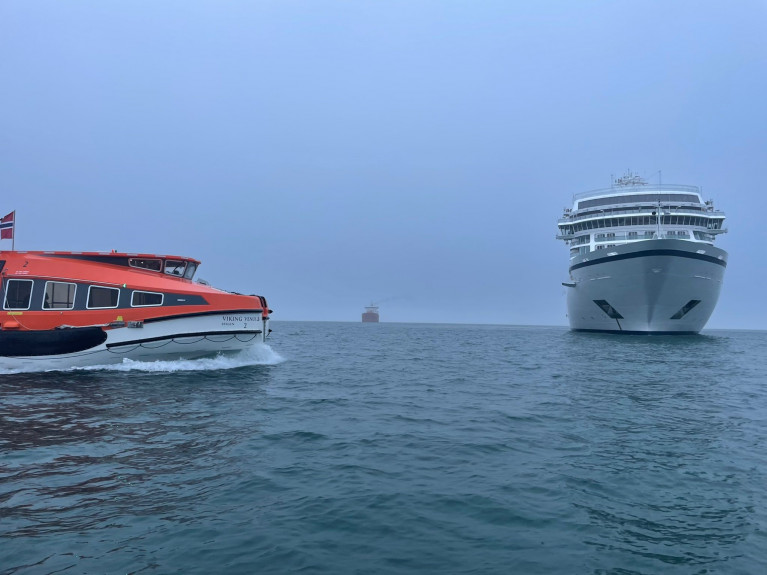Displaying items by tag: 1st 2022 cruise call
First Cruiseship to Irish Waters Since Pandemic Travel Restrictions Removed Makes Anchorage Visit off Dun Laoghaire Harbour
The first cruiseship in Irish waters since Covid19 restrictions were put in place more than two years ago but removed earlier this month, has led Viking Venus to visit Dun Laoghaire Harbour with an anchorage call this morning, writes Jehan Ashmore.
Afloat last night tracked Viking Venus in the Celtic Sea having departed from Dover. The Kent port forming a destination as part of a 14-day cruise that started from London (Tilbury) and terminates next month in Bergen, Norway. The cruise will include calling to Holyhead, other UK ports and the Shetland Islands.
At around 0630hrs a pilot boarded the 47,842 gross tonnage cruiseship in a foggy Dublin Bay so to enable an anchorage position to take place off Dun Laoghaire Harbour. The port operator, Dun Laoghaire-Rathdown County Council (DLRCC) expects more of these anchorage 'tender' calls in the region of 60 to be made this season.
Cruisegoers have been taken ashore by tenders and welcomed alongside Carlisle Pier. At the quayside, marquees are in place along with coach excursion providers awaiting those from the 930-passenger cruise ship. This follows the removal of strict Covid19 travel protocal restrictions from those travelling to Ireland which the Department of Health revoked on 6 March.
 Cruise goers are taken ashore by tenders and welcomed alongside the Carlisle Pier with awaiting coaches Photo: Afloat
Cruise goers are taken ashore by tenders and welcomed alongside the Carlisle Pier with awaiting coaches Photo: Afloat
The decision also applied to ferry passengers, has led to the reopening of the cruise sector that overall is worth €70m to the Irish economy. The development follows high levels of vaccination take up in Ireland, coupled with predictions of a strong recovery in the tourism sector this summer.
The season's inaugural call to Dun Laoghaire Harbour of the cruiseship, is operated by Viking Cruises with an operational office based in Basel, Switzerland. The company marks their 25th anniversary this year having begun its origins from running river-cruises in Europe.
As for cruisegoers on board Viking Venus, it is understood the majority of guests are mostly American and having paid USD $6,999 based on double occupancy rates on the cruiseship which was only built in April of last year by Fincantieri’s shipyard in Ancona, Italy.
A private veranda comes with every stateroom, while as for dining is concerned there is a choice of restaurants offering a variety of culinary options. For fitness and leisurely pursuits, there's an infinity pool, a Nordic-inspired spa, a two-deck Explorers’ Lounge with panoramic views. Those liking to reading, there are thoughtfuly curated book collections spead throughout the cruiseship.
As alluded above tenders from the 221m long cruiseship have ferried cruisegoers ashore to Dun Laoghaire's Carlisle Pier where a pontoon is provided to facilitate passengers with easier access. It is at the same pier where much smaller sized such ships have used this berth to disembark passengers.
The next scheduled 'in port' caller Afloat identified to be the Greg Mortimer which DLRCC has confirmed and also to arrive in mid-May.
On occasional calls over the years, they have included turn-around cruises. This has involved fly-cruises using Dublin with tourists transferred to and from Dun Laoghaire, where one set of passengers disembark to be followed on the same day with those embarking the cruiseship's gangway.
























































